Tripp-Lite isobar Surge Protector Tear-Down
Tripp-Lite isobar Tear-Down

Some of you asked for this, and forum member kyuuketsuki kindly offered to send a spare my way. So here it is: Tripp-Lite's isobar 8 Ultra.
A Staple Of IT
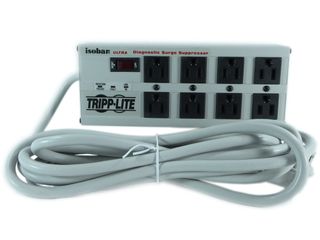
The isobar brand, which surfaced in 1982, quickly established itself as the go-to for office surge protection. Those of you old enough to remember may have noticed these boxes in government, education and medial environments about that long ago. The general external design remains mostly unchanged except for the switch, which went from stamped steel to an extruded aluminum housing. If it ain't broke, don't fix it, right?
From California
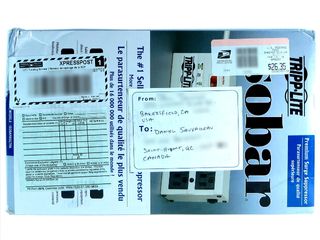
You may want to thank forum reader kyuuketsuki for punting this box all the way from Bakersfield, CA to Saint-Hubert, QC. Postage across the border costs half as much as buying one of these on sale. Most of the front is covered by the customs declaration, address, USPS and CP postage labels.
The naked box survived the trip in surprisingly good condition considering the distance. One of its corners does show signs of getting banged up worse than the other three, though.
Under The Labels
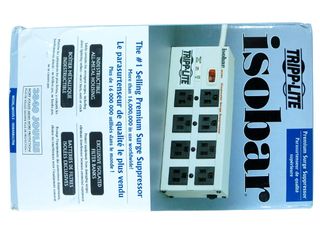
After half an hour of careful peeling and cleaning, I have a mostly clean box to take a picture of.
Aside from touting isobar as a best-selling surge protector and a 3840 joules rating, the only two other highlights featured on the front are the all-metal housing and isolated filters. When your product is the de-facto standard in so many institutions, there is no point in preaching to the choir or bothering with minor features nearly all other surge protectors also have.
The Other Side

Aside from the crumpled corner, there is no other obvious shipping damage on the back.
Stay on the Cutting Edge
Join the experts who read Tom's Hardware for the inside track on enthusiast PC tech news — and have for over 25 years. We'll send breaking news and in-depth reviews of CPUs, GPUs, AI, maker hardware and more straight to your inbox.
Most of the rear is dedicated to a brief overview of how the isobar's protection works, complete with an annotated picture highlighting the key components and their roles. I will save comments on the image for later, after I get a look at the actual PCB.
The bottom square lists slightly more detailed specifications than usual.
The Spiel

To make a long story short, the isobar's main claim to fame is simply using more and bigger components than competing products.
The Monster unit I looked at back in February possessed a common-mode choke but no inductors, while the SurgeArrest Performance from last summer had inductors but no common-mode choke. The isobar has both and some extras, making it the most complete of the three for power filtering and surge blocking.
The Ratings
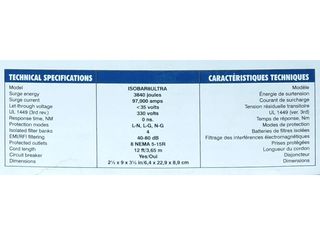
Aside from the cord length, 1449-rev3 surge voltage and energy rating, the most interesting specification listed is the 35V surge let-through. This is something usually associated with fancier surge protectors like SurgeX's older designs.
Also of interest (but for a different reason) would be that 97kA surge current specification. It needs to be taken with a pinch of salt; modern 20mm MOVs have a one-shot rating of 10kA, and with 10 MOVs total, the sum barely gets there. This is clearly marketing fluff – a value that should not be achievable in practice.
Extras
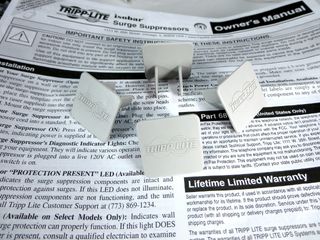
As part of your purchase, you get a folded sheet containing the owner's manual, warranty and miscellaneous other information. You also get four Tripp-Lite-branded outlet covers.
How many people actually use their power bars' outlet covers? I simply throw mine into a spare parts box.
The Plug
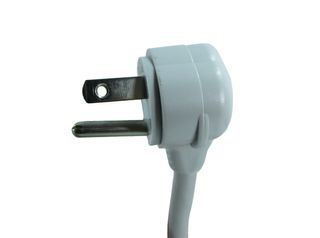
Inside the packaging, the power plug was tucked into the banged-up corner, which may explain why the ground pin has a slight inward bend. The plug size is about the same footprint as APC's, except the isobar's also has ears on the sides to provide extra grip, making it much easier to pull out. Cabling, on the other hand, is the usual PVC fare.
Spotting Differences

When companies update products, they sometimes opt out of printing updated packaging. Here, the artwork shows a plunger-style breaker on the right end-cap, while the actual unit uses an illuminated breaker-switch.
Rear View

The usual complement of warning and certification stickers adorns the rear cover (five in total if you include the tiny “QC pass” one below the serial number).
Wall-mounting accommodations are provided by bent ears extending from each end-cap, putting about one centimeter of clearance between the enclosure and whatever it rests or mounts on. Should a fire actually start inside, the surface supporting the isobar should be spared most of the heat and hopefully remain intact until the fire dies out.
-
blackmagnum "How many people actually use their power bars' outlet covers?" I do. They protect the power bar from pest such as ants, pets and toddlers.Reply -
Kewlx25 My only wish is they had a 10 port version. I have a lot of low wattage electrical devices to plug in and the warranty says plugging this into another surge-protector or plugging another surge-protector into it voids the warranty.Reply
I've tried to find a non-surge-protecting power strip, but no luck. -
ralanahm Thank you for the review. I am glad to see these turned out better than lower price ones and it wasn't all marketing hype.Reply -
cbrunnem whats up with this guys/sites hard on for power strips.... can you not think of better things to review?Reply -
ralanahm Thank you for the review. I am glad to see these turned out better than lower price ones and it wasn't all marketing hype.Reply -
nukemaster Reply15622774 said:whats up with this guys/sites hard on for power strips.... can you not think of better things to review?
The community reaction to the early power bar tear down was positive.
If you do not want to see these, just do not read them.
This author is very good at breaking these things down so users can see and understand what is happening inside the power bars they sell at the store.
Tom's Hardware has other reviews and reviewers. -
froozeball Thank you both for the review and the chance (ie the actual product) to review!Reply
Always insightful, well presented and very useful. Frankly it's about time somebody really tore down, explained, and held these products accountable to the public. You explain issues to the point, good or bad, and it's a great piece of technology journalism that you present.
Felicitations et merci! -
Daniel Sauvageau Reply
All the sub-$15 power strips I have looked at are simple MOV affairs: power cord -> switch/breaker -> MOV(s) with thermal fuse -> outlets. For most electrical applications, they are indistinguishable from a plain strip unless something goes wrong since a 20D201K MOV conducts less than 1mA until voltage passes 200V. Under normal circumstances, 120V line voltage peaks at 170V so the MOV does practically nothing. You may also want to consider the fact that most of your electronics with a line-operated switchmode PSU likely has an EMI filter and MOVs of their own, which means they have much more complex impedance than a basic surge-protecting strip.15622264 said:I've tried to find a non-surge-protecting power strip, but no luck.
The warning against daisy-chaining surge protectors is more about the possibility of loose connections between strips degrading protection on downstream strips, over-loading strips and other issues which may affect surge protection performance or safety.
I have a few different things in the works but I need to put together a few test jigs first to make my life easier. If you do not like power-related accessory tear-downs, you are free to not read them.15622774 said:whats up with this guys/sites hard on for power strips.... can you not think of better things to review?
That said, I am starting to run out of tear-down candidates in that department, so I plan to do something else every other month to stretch those out, like the LCD tear-down/repair that came out last month. -
Daniel Sauvageau Reply
It is comments like those that make the ridiculous number of hours it takes to put these things together worth it. The tear-downs may look very simple but between planning, workbench and editing time, I likely spend more than an hour on average on each slide that makes it in.15623007 said:Thank you both for the review and the chance (ie the actual product) to review!
Always insightful, well presented and very useful. Frankly it's about time somebody really tore down, explained, and held these products accountable to the public. You explain issues to the point, good or bad, and it's a great piece of technology journalism that you present.
Felicitations et merci! -
gtinut heat shielding material? you must kidding. It is standard to place no conductive layer on metal where components are located.Reply
Most Popular


